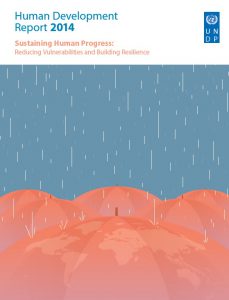Resource Title
Human Development Report 2014: Sustaining Human Progress – Reducing Vulnerabilities and Building Resilience
Summary
The UNDP’s HDR is an annual report that measures human development across the world.
The 2014 HDR focuses on vulnerability and its impact on human development. It argues that unless the issues affecting the most vulnerable throughout the world are ‘systematically’ addressed, through changing policies and social norms, development will be continue to be inequitable and unsustainable.
Resource Details
Description
The 2014 report focuses on ‘human vulnerability’ and ‘human resilience’ as it relates to the erosion of individual choice and capabilities and ensuring that individual choice is ‘robust,’ highlighting the need to support coping mechanisms to adjust to adverse events in the lives of the most vulnerable.
Packed with graphs, fact boxes, case studies and comments from a range of experts across many dimensions of ‘development’ the report is designed to used widely by educators, researchers and policy makers.
The report outlines that there are:
- More than 2.2 billion people either near or living in multidimensional poverty –deprivation such as poor health, lack of education, inadequate living standard, lack of income, disempowerment, poor quality of work and threat from violence
- Nearly 80% of the global population lack social protection, while 12% (842 million people) suffer from chronic hunger – and nearly half of all workers across the world are in informal or precarious employment.
The key messages of the 2014 report include:
- Vulnerability threatens human development. Despite the progress in human development over the years, recent gains have been challenged through ‘growing uncertainty’ as a result of ‘deeper and more frequent’ global shocks, such as financial instability, high and volatile commodity prices, recurrent natural disasters and environmental hazards, widespread social and political unrest, etc., resulting in further vulnerability of the world’s poorest.
- ‘Life cycle’ and ‘structural’ vulnerability and insecure lives are fundamental sources of persistent deprivation. Individuals are vulnerable throughout all stages of their life cycle—from infancy through youth, adulthood and old age—which can affect the formation of their life capabilities. Without the necessary support and investment during the various stages of a life creates long-term vulnerability. Structural vulnerability for example within social contexts, encourages discriminatory behaviours and creates barriers for people and groups to exercise their rights and choices, perpetuating their deprivations. The increased vulnerabilities that can arise from economic, environmental, physical, health and other insecurities slows human development and makes it much more difficult to recover from internal and external shocks.
- Universalism is a right. Everyone should have the right to education, health care and other basic services.
- The need for ‘full employment’ should be embraced as a universal goal, just as education or health care. To have a decent job is a fundamental aspect of building human capabilities.
- With global interconnectedness, vulnerabilities are increasingly global in their origin and impact, requiring collective action and better international governance on issues of: pollution, natural disasters, conflicts, climate change and economic crises
- A global effort is needed to ensure that globalization advances and protects human development. Consensus on ‘universal social protection’ to recognize the rights of all people to education, health care, decent jobs and a voice in their own future
- While acknowledging the key gains over the years in terms of human development the 2014 report adds a new dimension that is challenging global development, that of youth unemployment, in particular within developing countries. This is increasingly an issue as more young people are able to access education throughout the world and expect to be able to secure employment once they graduate.
Big ideas in the 2014 report:
- An important communication of the 2014 report is the promotion of universalism, such as the universal right to education and healthcare, as a guiding principle for policy formulation at public and private levels:
“It is possible and cost-effective to push for universal access to basic social services in most developing countries.” (Khalid Malik, report lead author)
- The report promotes the idea that we are all interconnected and that successes in human development requires global action.
- The world is changing rapidly. The scope and scale of connectivity and related insecurities are accelerating, as are the threats of contagion and exposure to natural disasters and violent conflict
- The intersecting or overlapping vulnerabilities arising from economic, environmental, physical, health and other insecurities magnify the adverse impact on freedoms and functions
Further reading
- A short ‘conversation’ with the lead author Kahlid Malik with the Asia Foundation
- The FAQs are really very helpful in further exploring and learning about the Gender Development Index (GDI); Human Development Index (HDI); Inequality-adjusted Human Development Index (IHDI); Gender Inequality Index (GII); Multidimensional Poverty Index (MPI)
- The Human Development Data Visualisations a competition organised by the Human Development Report Office (HDRO) to interpret human development data through visual media – infographics or interactive visualizations and provided an original and thought provoking illustration of human development.
Available from:
Download the 2014 Human Development Report PDF (16.2MB)
Visit the 2014 report website https://hdr.undp.org/en/2014-report
Visit the interactive data map to explore data indicators and country info https://hdr.undp.org/en/countries and the public data explorer https://hdr.undp.org/en/data-explorer or download any of the data tables https://hdr.undp.org/en/data
Report also available to order for $45 from UN publications.

